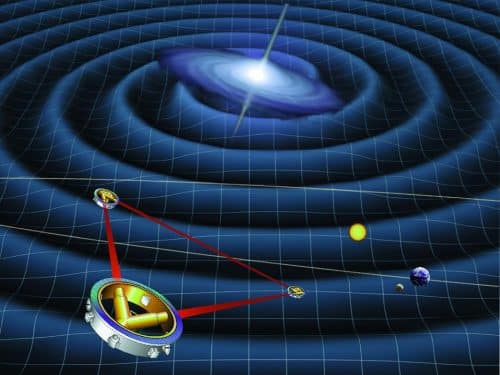The discovery allows a glimpse of one of the most violent phenomena in the universe - the merging of black holes

In 1915, Einstein explained that gravity results from large bodies distorting space and time or space-time, causing free-falling objects to appear as if they were landscapes in a curved path like the arc of a stone's throw or the ellipse of a planet's orbit around the sun.
Einstein calculated that a dumbbell-like distribution of mass spinning from end to end like a wand, should radiate ripples in space-time moving at the speed of light - these are gravitational waves. On February 11, scientists working at the Laser Interferometer Gravitational-Wave Observatory (LIGO) - a scientific facility that is part of the state of Washington and part of Louisiana - announced an observation that proves what Einstein predicted - an eruption of waves created when two black holes swirl towards each other at a distance of 1.3 billion years Light from us.
The achievement required hard work. Einstein himself estimated that it would take decades to prove the existence of gravitational waves if they do exist, but even if he were to search, the only source he could imagine - two stars orbiting each other and spinning would not produce waves of detectable intensity. However, at the end of the sixties, they discovered much more massive objects - neutron stars and predicted the existence of black holes - the most compressed gravitational fields found in stars that shrink to nothing. When they swirl together, observable gravitational waves may be created. In 1972, Rainer Weiss, a physicist at MIT, outlined the methods for making discoveries using L-like devices called the Interpreter, thus defining the need to build LIGO.
Each LIGO interpreter contains two arms containing mirrors at each end - these mirrors are located in huge vacuum chambers. By shining laser light between the mirrors, the physicists can measure the length of the arms to within an error of 1/10,000th the width of a proton. A passing gravitational wave will cause the arms to stretch to different lengths, which is what the LIGO team discovered. The close correlation between the first signal and the computer models that validated Einstein's theory of general relativity was the best ever seen.
Now scientists are looking forward to what's to come, because gravitational waves promise a whole new way to look at the universe. In the first phase, the physicists hope to discover many more events of this type. LIGO has already detected a second merger of black holes and a third, albeit weaker signal. The interferometers resumed operation in November 2016 and if they reach their designed sensitivity, they may finally see black hole mergers at a frequency of one per day.
LIGO will be joined by other instruments such as the upgrade of the Italian VIRGO facility and a new detector being built in Japan - the Kamyoka gravitational wave detector. Three or more detectors working together will be able to pinpoint the source of the signal in the sky using the triangle method. This would allow the telescopes to focus on the event and possibly even detect other signals from it. For example, if the gravitational wave detectors sense the merger of two neutron stars and the astronomers point telescopes towards the event, they will be able to capture light or X-waves emitted from it. Combining the signals together will make it possible to know more about the exotic materials in neutron stars. Other familiar phenomena that can be seen in a new light are the pulsars - spinning neutron stars that emit regular pulses of radio.
In the future, the scientists intend to send such an antenna to space Laser Interferometer Space Antenna (LISA).. Three spacecraft that will move in coordination around the Sun, creating a virtual interferometer with arms that are millions of kilometers long and will allow LISA to sense weaker and more distant gravitational waves and thus observe more black hole merger events as well as observe in an event at much earlier stages than can be detected on Earth with facilities such as LIGO.
LISA was supposed to be a joint project of NASA and the European Space Agency, but America withdrew from it in 2011 due to budgetary constraints. Now NASA wants to hold on. The European Space Agency hopes to launch the $1.5 billion mission in 2034, around the time physicists plan to build the next generation of ground-based detectors.
More of the topic in Hayadan:
- 2016: a fascinating scientific year
- First direct evidence of the existence of gravitational waves that caused the universe to swell immediately after the big bang
- How does the telescope at the South Pole that discovered the gravitational waves created by the Big Bang work?
- What are gravitational waves?
- An attentive ear to the echoes of the Big Bang

2 תגובות
Absolute genius. , the more you get away from his era from the intensification of general relativity, I wish there was another one like that
Here is an example of the time constants of proving a theory in physics. Creates a dilemma for the Nobel Prize winners. They are reduced to micro issues such as the improvement of the optical microscope, or hope that in the lifetime of the theorists at the end of their days there will be a proof experiment, or give the prize for something else - as in the case of Einstein. And another point. After a sequence of 4 Nobel Prizes to Israelis (Hershko/Tschanover, Gross, Oman, Yonat Ada) we made sure to eliminate any chance of receiving further Nobels, as easily as they damage strategic relations as if they were a fight in kindergarten. The Swedes are anti-Semitic as a country and not just the foreign minister. Even if this is true, they awarded 4 Nobel Prizes to Israelis. I wonder who won - she, thanks to her work, no more Nobel Prizes will be awarded to Israelis, or us.